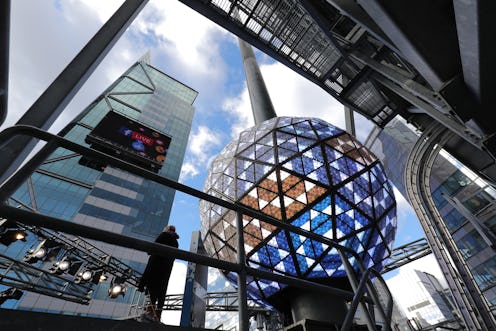Life
Why Do We Drop A Ball On New Year's Eve? Here's…

Everybody knows that New Year's Eve is the one time of year where it's acceptable to drop the ball. Dad jokes aside, dropping the ball in Times Square is probably one of the most famous New Year's Eve customs. But have you ever stopped to wonder why we drop a giant sphere from the sky to signal the start of a new year? Believe it or not, this Times Square tradition has a long history, so let's take a look at why we drop a ball on New Year's Eve.
According to the official website of Times Square, the first ball was lowered from the flagpole that sat on top of One Times Square in 1907. The ball was made of iron and wood and decorated with 100 25-watt lightbulbs, which is honestly kind of funny to imagine. The original ball was used every year up until 1920, when a new one replaced it. To contrast, the 2007 centennial ball was lit with multicolored LED lights — in other words, we've come a long way since 1907. Since the first ball drop, we've continued the tradition every year except 1942 and 1943. During those years New York City was on a dim-out, meant to protect against air and naval attacks during World War II. But every other year, without fail, we've dropped the ball from Times Square.
Okay, so we know that we continue to drop the ball because basically we've been doing it for the past century and change — but who thought of lowering a giant light-up ball from a flagpole in the first place? And why? Actually, the tradition didn't originate on New Year's Eve, or even for the holiday specifically — people had been dropping balls to indicate the passage of time since the 1800s. The first "time-ball" was installed in 1833 in Greenwich, England, on top of the Royal Observatory. Every afternoon at exactly 1pm, the ball would lower so that captains in nearby ships could sync their chronometers (basically, a tool for measuring time that helped determine longitude — very important, in other words).
Eventually, time-balls were set up in cities other than Greenwich and would descend from flagpoles at noon. (A few places, like the Naval Observatory in Washington, D.C. still continue to do so.) Somewhere along the line — I guess in 1906 – somebody got the bright idea to drop a ball from Times Square not at noon, but at midnight to signal the arrival of a new year. And I guess people liked it so much that the tradition stuck.
So there you have it. Feel free to recite this newfound knowledge at your New Year's Eve party — or not.
Images: Giphy (3)